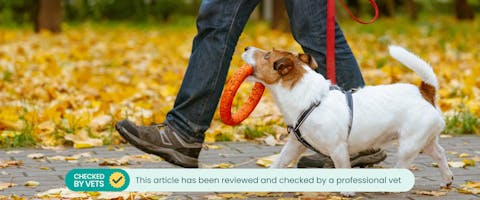Updated 15/11/2024
A trained dog is a happy dog. It helps them learn good behaviors from bad, makes your life as a canine carer easier, reduces their anxiety (and yours), and provides them with important mental stimulation. But what are the must-have dog training tools every pup parent should need? We’ve outlined the top 10 tools and dog training essentials to make sure you’re as prepared as possible to teach your dog some new tricks.
Trending posts
Purr-use some of the top blogs our members have been loving this month- Top male dog names for your new furry friendGot a new furry family member in your pack? Check…

- Top female dog names for your new fluffy palWelcoming a new pooch into your family? Explore…

- 250+ gray cat names your silver feline will loveRecently welcomed a fluffy gray bundle of joy into…

- What are normal pet sitting rates?Discover the average pet sitting rates for animals…

- Unique dog names to stand out from the packDare to be different with our list of the best…

10 must-have dog training tools
1. Retractable leashes
Sounds obvious, we know, but this is a common dog training essential. For puppies or newly adopted adult dogs, retractable leashes can allow them to explore slowly while you work on their recall. Similarly, if you know your doggo is triggered by other people or dogs, these leashes help to keep your pup near you. However, always be careful with retractable leashes, as they can malfunction, and can also cause injuries.
2. Long leash
These can be retractable leashes or just long leads, it’s up to you. But a long leash offers some extra freedom for your pooch if they have to remain on a lead. They’re great for beach walks and hikes and are excellent for practicing recall training.
3. Treat pouch
Pups will probably tell you this is the most im-paw-tant of all their dog training stuff, and they wouldn’t be wrong. Dogs thrive on positive reinforcement and the more you can reward good behavior, the quicker they are to learn. Find a treat pouch that is easy to carry (many clips around the waist) but also relatively discreet. Oh, and make sure they’re definitely dog-proof!
4. Tasty training treats
And what will you keep in your magic treat pouch? Yummy doggo snacks, of course! These can be store-bought snackies or home-prepped treats, basically whatever instantly catches your dog’s attention. If you’re starting out with dog training, try to use small snacks that are low in fat and calories. If you’re doing a lot of training, and therefore using lots of treats, remember to reduce your dog’s daily food portion accordingly.
5. Clicker training tool
The clicker is a must for all hearing dogs! Training your dog to associate commands or recall with a click sound can save you a lot of time and energy. Let them learn that this sound means they need to do something and they’ll be rewarded if they do it.
6. Flat collar or harness
Keeping your pup secure as well as comfortable during their training is equally as important. A flat collar or well-fitted harness (whichever your dog prefers) is ideal for outdoor training time. If they suddenly need to be grabbed or picked up, these accessories will allow you to do so safely and with as little harm to your dog as possible.
7. Books by professional dog trainers
Who better to help you and your pup along your training journey than tips from the training professionals themselves! Whether it’s deciding how to train your dog, learning simple and easy techniques to repeat at home, or just some reassuring words of wisdom, having at least one professional dog trainer book in your library can make a big difference.
8. Target stick
The nifty target stick is great for teaching your dog how to stay on target while on walks (like where to heel and to stop them walking you), or as a tool for trick training (spins, lie down, jumps). Some even come as a combined clicker training tool too, and can often come as a retractable stick making it easy to store or bring on walks.
9. Dog crate
Your dog’s crate will always be an important feature of their home life. Whatever type of crate you decide on, these act as essential for potty training (at any age) and also create a safe space for your pup to hang out after a long day of being a dog. Introduce crate time slowly, and make it a positive experience so that your dog enjoys spending some chill time there.
10. Chew toys
Dogs are highly motivated to chew – and better a chew toy than your furniture! You can get ones that also dispense treats, or that you can hide treats inside of. Chew toys can be offered as another reward or positive reinforcement. Not only is it fun for them, but chew toys can also be a comfort during things like anxiety training. Try to have one to hand on walks or where you might encounter stressful situations.
Meet our veterinary expert, Lizzie
This article has been checked by veterinarian Lizzie Youens BSc (Hons) BVSc MRCVS. Lizzie graduated from the University of Bristol in 2011, and has been working in first opinion companion animal practice. She has worked in a variety of clinics across the UK, from large hospitals to small branch practices. She enjoys doing a mixture of medicine, surgery and emergency work. Lizzie currently works in a small rural practice where she enjoys working in a close-knit community.
For more tips and tricks on dog training, check out our beginner's guide for training puppies to find out where to start when they’re at their smallest. Otherwise, head to our Community Forum - connect with other canine carers and pet lovers, swap wisdom and reassurance to spread the love for our favorite furry friends.

